Oil tankers play a crucial role in the global economy, transporting vast quantities of crude oil and refined petroleum products across oceans and seas. Given this importance, understanding the capacity of oil tankers, specifically in terms of gallons, is vital for stakeholders in the oil and shipping industries.
Overview of Oil Tanker Types
1. Crude Oil Tankers
These are vessels designed specifically to carry unrefined crude oil. The capacities of crude oil tankers can vary significantly based on their classifications:
| Type | Capacity Range | Typical Use |
|---|---|---|
| Very Large Crude Carrier (VLCC) | 1.5 to 2 million gallons | Transporting crude oil over long distances |
| Suezmax | 1 million gallons | Navigating through the Suez Canal |
| Aframax | 600,000 to 1 million gallons | Medium-range deliveries |
| Panamax | 300,000 to 600,000 gallons | Suitable for Panamax locks |

2. Product Tankers
Product tankers are designed to transport refined products like gasoline, diesel, and jet fuel. Their capacities also vary widely:
| Type | Capacity Range | Typical Use |
|---|---|---|
| Handysize | 300,000 to 600,000 gallons | Short-haul deliveries |
| Medium Range (MR) | 600,000 to 900,000 gallons | Flexible transport for different fuels |
| Long Range (LR) | 900,000 to 1.2 million gallons | Long-haul shipments |
3. Chemical Tankers
These are specialized tankers for transporting chemicals, which require specific equipment and design modifications. Their capacity also varies significantly:
| Type | Capacity Range | Typical Use |
|---|---|---|
| IMO 1 | 300,000 to 900,000 gallons | High hazard chemicals |
| IMO 2 and 3 | 100,000 to 500,000 gallons | Moderate to low hazard chemicals |
By understanding the various types of tankers and their capacities, manufacturers and operators can optimize their fleets for particular transport needs.
Capacity Breakdown in Gallons
Now that we understand the types of oil tankers, let’s dive deeper into their capacities to illustrate how many gallons can be transported by each type.

Typical Capacities
An overview of the capacities helps in visualizing the scale of operations:
- VLCC (Very Large Crude Carrier): Typically carries between 1.5 to 2 million gallons.
- Suezmax: Can transport about 1 million gallons.
- Aframax: Usually holds around 600,000 to 1 million gallons.
- Panamax: Generally accommodates between 300,000 and 600,000 gallons.
- Handysize: Ranges from 300,000 to 600,000 gallons for short-haul deliveries.
- Long Range 1 (LR1): Often carries 900,000 to 1.2 million gallons.
Calculating the Total Capacity of an Oil Tanker
Understanding how many gallons are in an oil tanker is not just about knowing the types, but also knowing how to calculate total capacity effectively.
Formula for Volume Calculation
Length x Width x Height of the cargo tank in feet, converted to gallons via: [ 1 \text{ cubic foot} = 7.48052 \text{ gallons} ]
For practical applications, suppose a VLCC has a cargo tank:
- Length: 900 feet
- Width: 140 feet
- Height: 55 feet
The total volume in cubic feet will be: [ 900 \times 140 \times 55 = 6,930,000 \text{ cubic feet} ]
Now convert it to gallons: [ 6,930,000 \times 7.48052 \approx 51,800,000 \text{ gallons} ]
Thus, a standardized VLCC could hold roughly this amount when full, although operational capacities may differ.

Operational Considerations When Shipping Oil
Safety and Regulations
Shipping oil isn’t without its complications. Various regulations govern how oil can be transported, including:
- International Maritime Organization (IMO) Regulations: Ensures safe transportation and minimizes the risk of spills.
- Environmental Protection Agency (EPA) Guidelines: Protects coastal waters from potential pollution.
- International Convention for the Prevention of Pollution from Ships (MARPOL): Addresses pollution from oil spillages.
Economic Factors
Oil tanker capacities also have significant implications for the global economy, impacting everything from fuel prices to supply chain considerations.
- Market Fluctuations: Changing prices in the oil market directly affect shipping costs.
- Supply vs. Demand: The availability and demand for oil can shift rapidly, influencing tanker operations efficiently.

Logistics
The logistics of oil transportation require strategic planning:
- Loading and Unloading: Efficiency at ports to minimize turnaround times.
- Route Optimization: Strategic routing for fuel efficiency and timeframe management.
Comparison with Other Shipping Vessels
To put the capacities of oil tankers into perspective, let’s compare them with other common freight vessels, such as container ships and bulk carriers.
Capacities of Various Vessel Types
| Vessel Type | Typical Capacity (in gallons) | Notable Characteristics |
|---|---|---|
| Container Ship (Post-Panamax) | 20 million + gallons | Designed to carry large volumes of cargo |
| Bulk Carrier | 3 million to 4 million gallons | Primarily used for raw materials |
| LNG Carrier | 16 million gallons | Specialized for liquefied natural gas |
Oil tankers are tailored for specific loads, making their classification pivotal in maritime transport.

Environmental Impact of Oil Transportation
As oil tankers traverse the seas, they inadvertently contribute to environmental concerns. Spills, emissions, and operational waste are significant points of focus.
Spill Response Initiatives
- Preparedness Plans: Extensive training and protocols for oil spill incidents ensure rapid response.
- Technological Advances: Innovations in double-hulled ships minimize leak risks.
Emissions Control
With increasing regulatory pressure, oil tanker operators are now incorporating technologies to:
- Reduce Sulfur Emissions: Adoption of cleaner fuels or scrubbers.
- Improve Fuel Efficiency: Streamlining designs and operational practices to lower overall carbon imprint.

The Future of Oil Tankers
As we continue through a period of transition regarding energy sources, the future of oil tanker transport is under scrutiny.
Innovations on the Horizon
- Alternative Fuels: Companies are exploring the use of LNG or hydrogen as viable fuel options for tankers.
- Automation and Digitalization: Implementing advanced navigational systems and data analytics for real-time decision-making.
Regulatory Changes
In light of global climate commitments, the maritime industry expects shifts in regulations affecting oil transport, promoting sustainability while balancing operational costs.

Conclusion
In closing, oil tankers represent a fundamental mechanism in the global oil supply chain, with capacities ranging widely based on design and purpose. Understanding how many gallons an oil tanker holds is crucial for a variety of stakeholders, from manufacturers to shippers and regulators.
By analyzing these vessels, as well as their environmental impacts, operational efficiencies, and regulatory frameworks, we can appreciate the intricate web of factors that influence their use in the global economy. As industrial practices evolve and regulations tighten, the shipping community must adapt to new challenges in sustainable energy transportation, emphasizing the need for innovation within the industry.
Through careful consideration and planning, we can ensure that oil transportation remains safe, efficient, and environmentally responsible well into the future.



